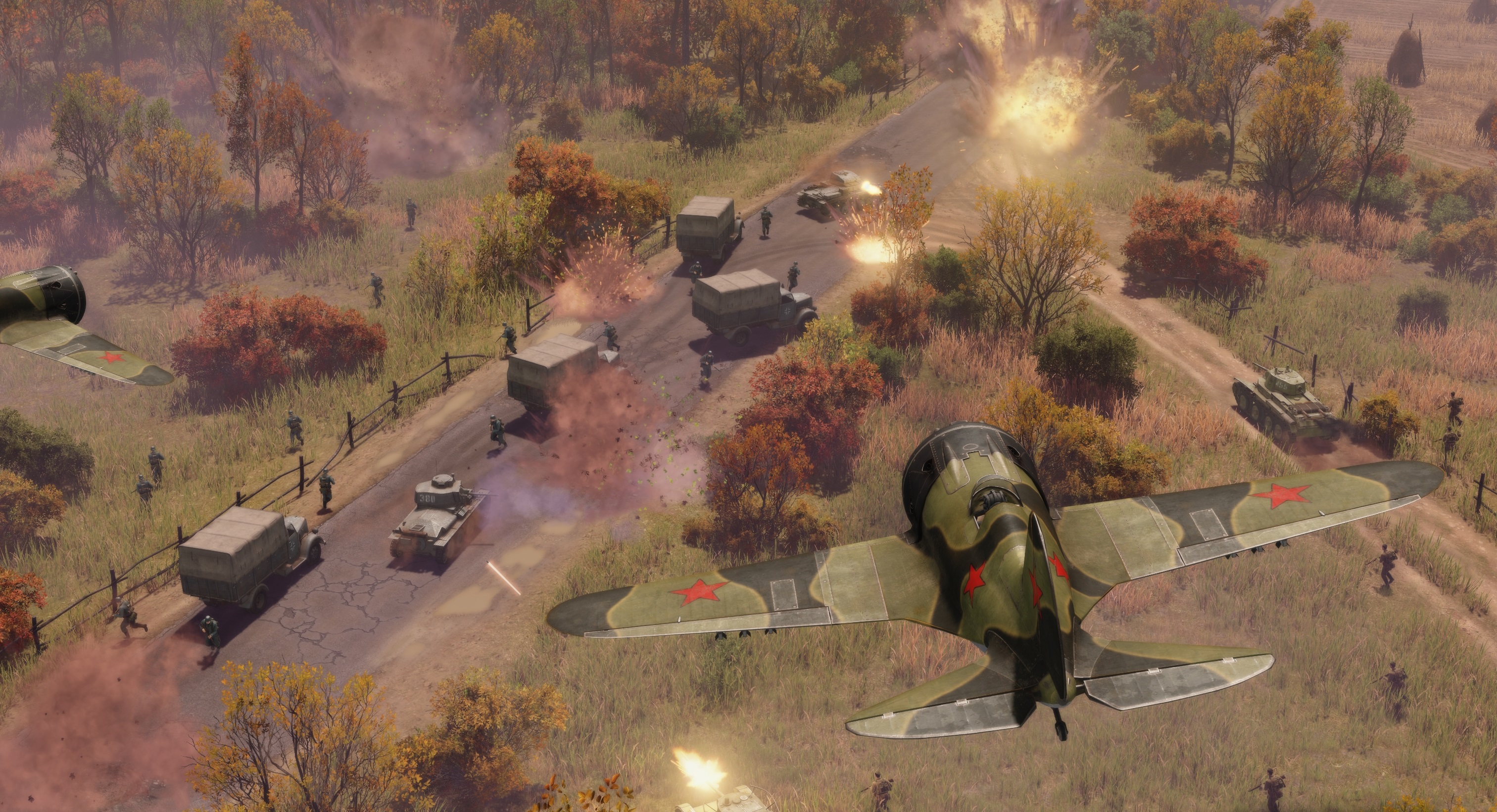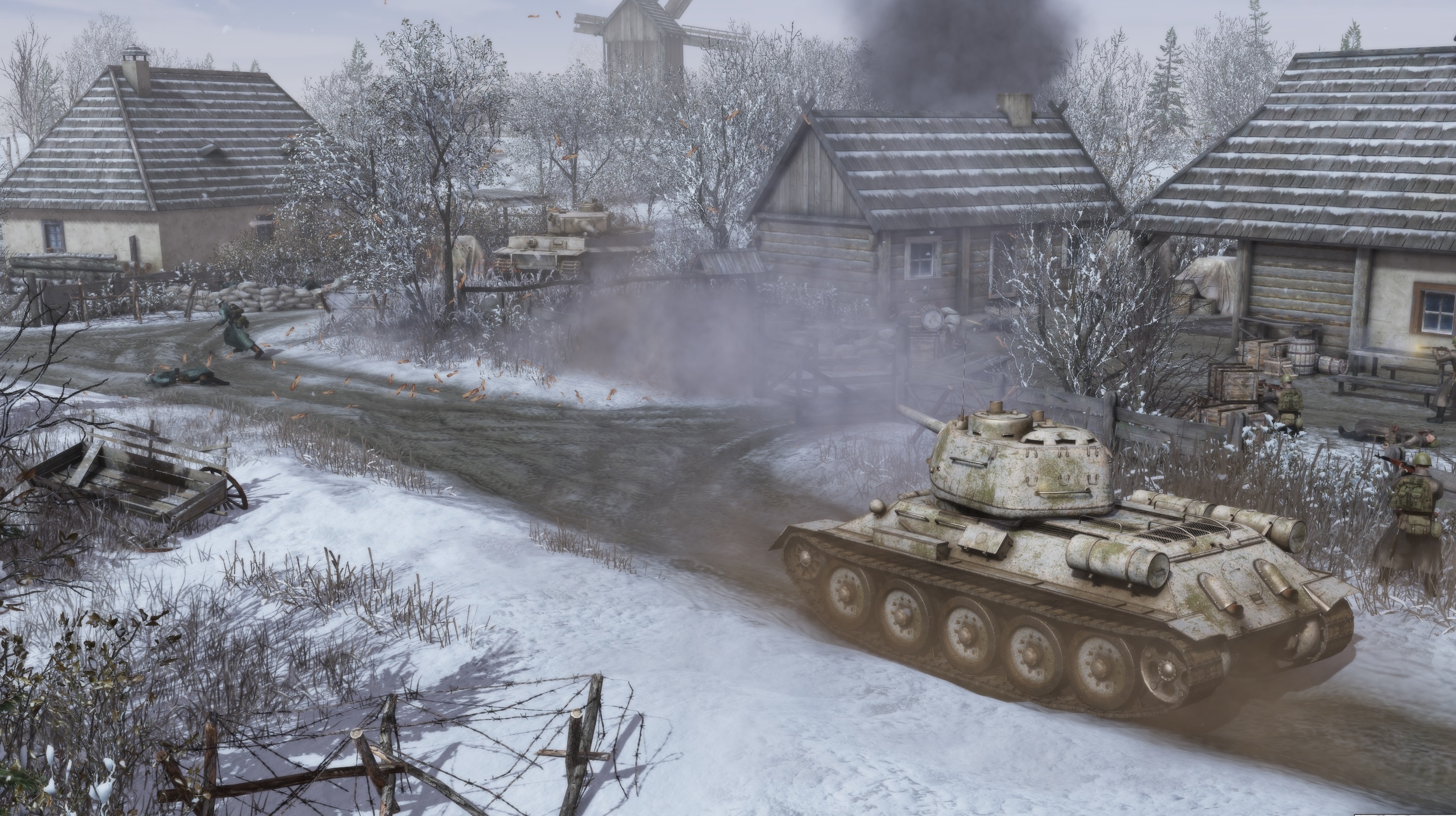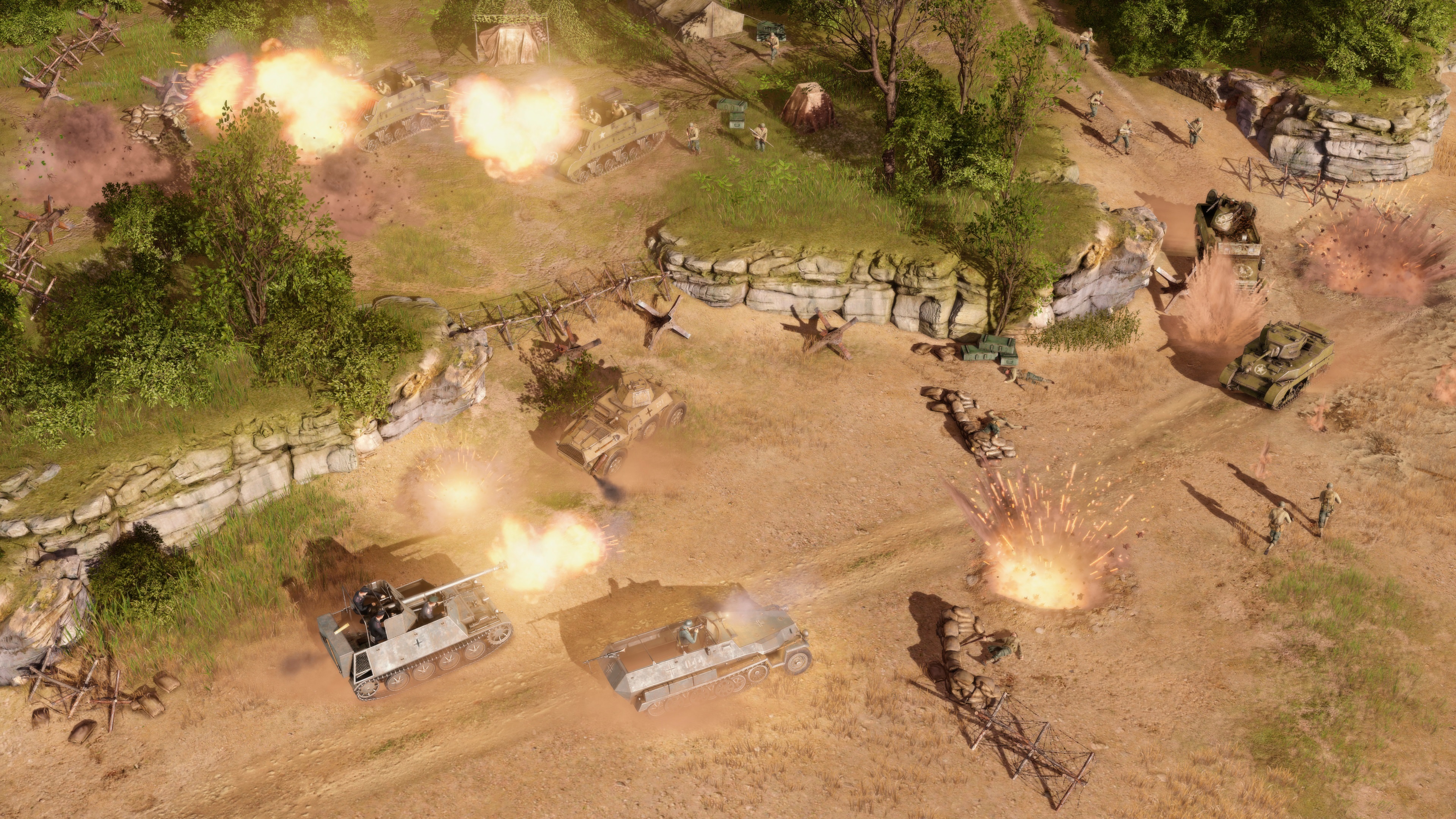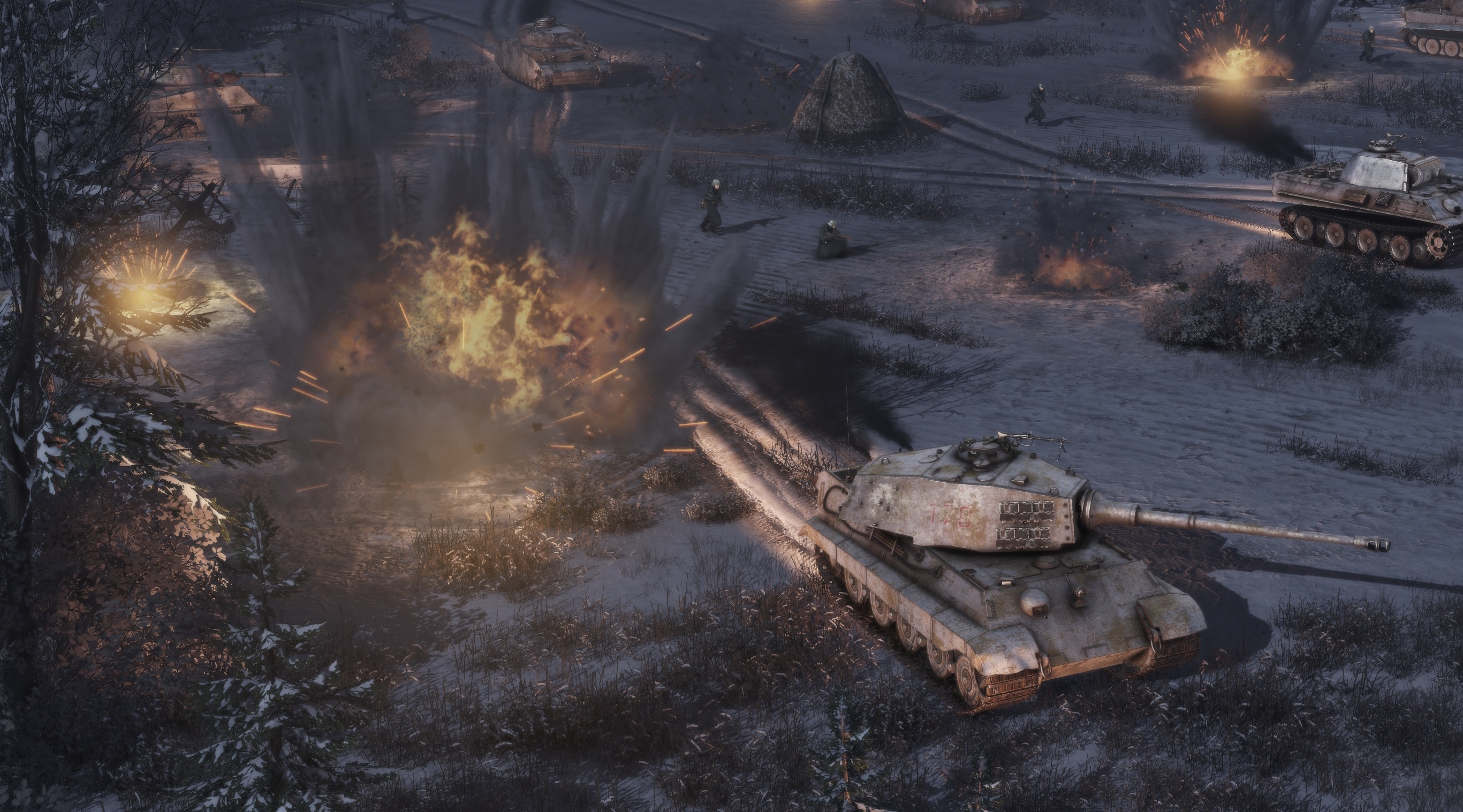It’s summer 1941, and Operation Barbarossa rolls its way east. The Wehrmacht is pouring into Soviet-occupied territory, and I’ve been given the task of holding the Germans back. Which is fine, great, peachy even. There’s just one small problem: I have absolutely no idea what I’m doing.
The opening mission for Men of War 2’s preview demo—one of three available—has dumped me into the thick of an entrenched battle between the Soviets and the Nazis, across a wide, flat frontline crisscrossed with trenches and sprinkled with pockets of both friendly and enemy forces. Taken aback by the scale of the battle, I cautiously move my soldiers to man a couple of nearby mortars, and use them to drive the Germans out of their hidey holes.
“Good,” says Men of War 2. “Now take these artillery guns and hold off the main offensive.”
Main offensive? Oh, shit.
Across the frontline, a thunderhead of German armour rumbles into view—dozens of tanks accompanied by dozens more soldiers. I frantically manoeuvre the artillery—some of which are drawn by horses, by the way—into even-ish positions across my line, then decouple them from their transports. Immediately, they begin raining hell on the German armour, turning tanks into smouldering husks and scattering ragged bodies from obliterated half-tracks.

I’m flying entirely by the seat of my pants, but a glance at the minimap tells me that the German armour is pushing deep into my right flank. I move one of the guns from the centre to stop this rapidly growing salient, and a well-placed shell instantly halts an entire column of armour behind a freshly wrecked tank. At this point, the tide of the battle turns, and it isn’t long before the Germans are in full retreat. I’m about to sit back and bask in the glory of my (very fortunate) victory, but then the commander tells me to take a bunch of tanks and destroy the bridges that the Germans have just fled across.
Shock and awe
Men of War 2’s opening demo mission showed me two things. First, Best Way’s strategy sequel is no slouch in the fireworks department. The battle I just fumbled my way to victory in represents one of the most impressive spectacles I’ve seen in any strategy game. From the way-tracer fire from rifles and machine guns kicks up dirt at the feet of enemy soldiers, to the way shells thud into enemy armour and burst buildings, sending splinters and rubble flying. When its combat engine is in high-gear, Men of War 2 is dramatic, cacophonous, and exhilarating.
Second, and this may seem counterintuitive, but Men of War 2 is shaping up to be surprisingly accessible. While my introduction to the game was rather fraught, most of my comprehension problems came down to a lack of proper tutoring. Don’t get me wrong, there’s a still a lot of depth to grapple with—this is a game that lets you take control of both individual soldiers and entire armies. But what I needed to do was always clear, while how to do it was always easier to fathom than I anticipated.

Take the frontline mechanic, which is one of Men of War 2’s big new features. The frontline is a demarcation of territory that dynamically adjusts based on the position of infantry units. In game terms, your frontline affects factors like where you can call in reinforcements, or your ability to build defences like trenches and fortifications. But it also provides an at-a-glance overview of a battle, letting you see where you need to shore up your defences, and where your opponent might be vulnerable to attack. Moreover, while each individual unit can perform a wide range of different actions, from throwing items like grenades and knives right down to switching the fire mode on their weapons, the UI for all this is fairly pared-back and straightforward, meaning it doesn’t take too long to figure out the basic functionality of units.
Balance the scales
Yet it’s important to stress that, while Men of War 2 can play effectively at this larger scale, it isn’t specifically about that. It aims to offer similar tactical chewiness at a smaller scale too. The demo’s second mission whisks players away from the Eastern front to the hedgerows of Normandy, where you’re given command over a trio of Sherman tanks and tasked with escorting a convoy through German-occupied territory. It’s a more stringent exercise in resource management, and also highlights the depth of the game’s vehicle simulation. In typical fashion, your tanks are strong at the front but vulnerable at the rear, but taking hits from tank shells or panzerfausts can also wreck your tracks, disable your gun, and even kill off specific members of the tank crew, affecting its function.
This mission also provides a fine opportunity to test out Men of War 2’s Direct Control system, which lets you personally assume agency over a specific unit. I order two of the Shermans to assault a German checkpoint, while jumping into the driver’s seat of the third. When an armoured German relief unit appears on the flanks, I’m able to draw the fire of the enemy tanks and direct my shells into their flanks, while the other two Shermans safely pummel them from a distance. While it’s hard to judge how useful direct control will be when there’s a larger number of units to manage, it’s useful for getting the upper hand in skirmishes or positioning units exactly where you want them to be.

The third mission zooms in further still, putting you in control of a single squad of US paratroopers who must seize control of a nearby German communications station. They’re massively outgunned, however, so their first task is to steal an armoured car patrolling the nearby forest. My first attempt at this mission is a slow stumble toward failure. I heedlessly attack the patrolling car, hoping the woods will serve as cover. But trees aren’t the best protection against heavy machine gun fire, and not only do I lose two of my five squaddies, a rogue grenade thrown by a surviving paratrooper blows the car up. I manage to nab a half-track parked further up the road, but this proves insufficient to push the Germans out of their entrenched position at the station, and I end up losing the mission.
Duck and cover
For my second attempt, I’m more cautious, using my squad’s ability to build fortifications to erect a small wall of sandbags by the road. This provides ample cover from which to take out the crew of the armoured car. I then use the car to eliminate the crew of the half-track as well, meaning I have two armoured vehicles to assault the communications station with. I take the station with ease, suffering zero casualties.
Together, the three missions highlight the flexibility at the heart of Men of War’s 2 systems, how your low-level decisions can snowball into a scenario that makes or breaks your entire mission strategy. The effect of your choices is always visible. That it is visible in such explosive style is a welcome bonus.

What’s important now is that Best Way ensures that the onboarding helps players grapple with the game’s depth. While I muddled through the scenarios to a reasonable degree, it wasn’t without some frustration. Managing infantry is particularly tricky—not because they’re especially complex to command, but because they are so incredibly vulnerable, and a single misplaced move can see half your forces shredded by an MG42 or blown into the stratosphere by an 88.
Players need to be equipped not just with tooltips and basic instruction, but proper tutorials that provide detailed tactical overviews, like how to approach a fixed gun emplacement with an infantry squad. But if the Ukrainian studio can make Men of War 2 sufficiently easy to learn, I can see myself spending many hours mastering it.

